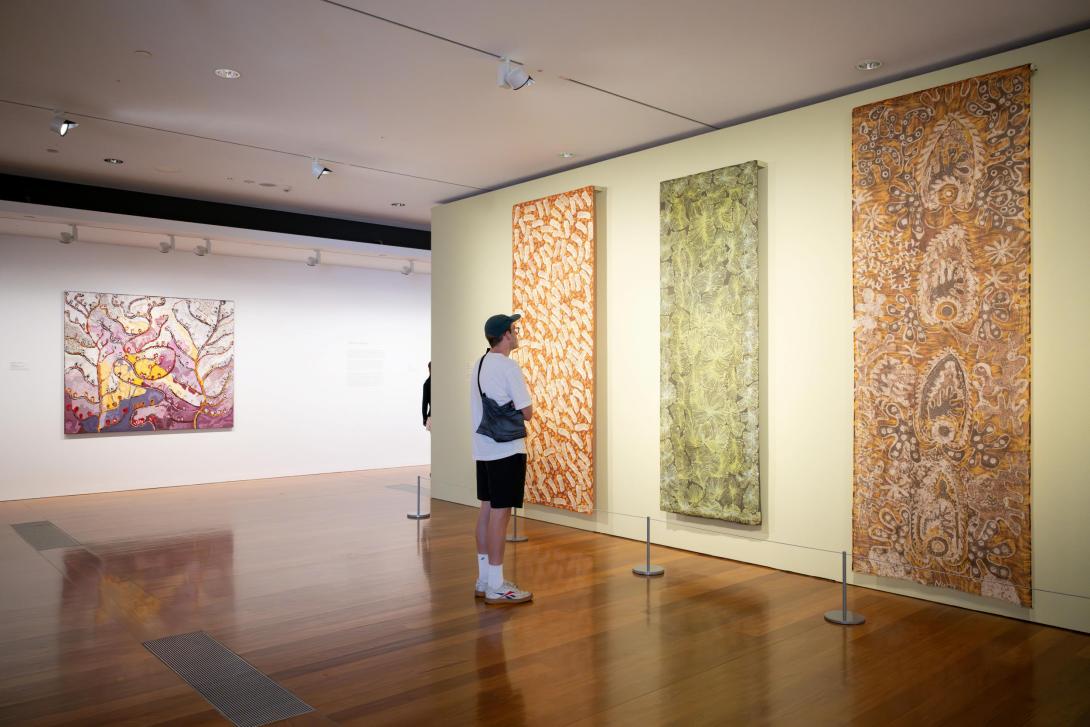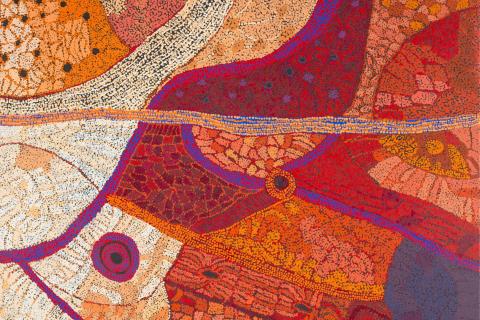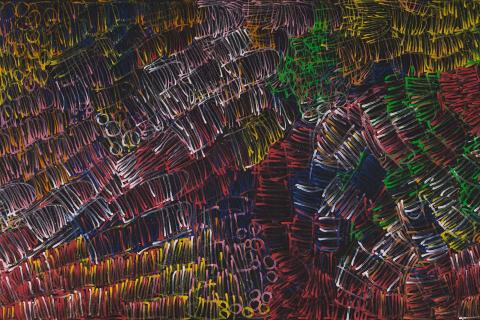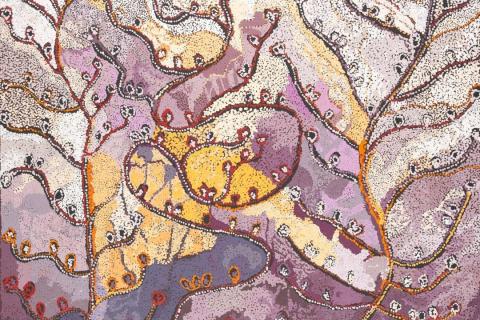INTRO: ‘Seeds and Sovereignty’
Over generations, Aboriginal and Torres Strait Islander people developed an intricate understanding of their Country’s unique environments and ideal ecological balance. Intertwined with cultural knowledge and ceremonial practice, this insight is embedded into societal systems, wherein totemic relationships of responsibility to flora and fauna ensure ongoing land management and sustainability.
Native plants provide nourishment, healing and the raw materials to create functional and ceremonial objects, shelter and tools for hunting. Their seasonal occurrence has tremendous ecological and theological importance in Aboriginal and Torres Strait Islander cultures. Lessons embedded into cultural stories, ceremony, art, dance and Songlines — refined over millennia of caring for Country — contain information critical to the safe use and sustainable collection of natural resources.

A view of ‘Seeds and Sovereignty’, featuring (l–r) Nellie Ngampa Coulthard’sTjuntala Ngurangka (Country with Acacia Wattle) 2018; Glory Ngal’s Textile length: Tharrkarri (Honey grevillea) 1996 / © Glory Ngal; Emily Kame Kngwarreye’s Textile length c.1989; and Nura Rupert's Textile length c.1982, GOMA, March 2024 / © The artists/Copyright Agency (unless noted) / Photograph: C Callistemon, QAGOMA
‘Seeds and Sovereignty’ brings together works from QAGOMA’s Indigenous Australian Art Collection that celebrate these interconnected relationships between plants, people and Country. The works chosen are thematically responsive to the scholarship of Dark Emu author Bruce Pascoe,1 Zena Cumpston, Bill Gammage and many other researchers whose work successfully challenges accepted histories and pervasive beliefs around the lifestyles of pre-colonial Indigenous people.2 This ground-breaking research recognises the sophisticated land management practices referenced in these artworks, while reaffirming the sacred obligations of custodianship that underpin their success.
Emblematic of the efforts of Aboriginal and Torres Strait Islander peoples over vast timelines, Danie Mellor’s Matter Matters echoes the dramatic roots of the ancient grey mangrove species (Avicennia marina). Commonly found in tropical and subtropical intertidal regions, mangrove colonies are essential for ecological balance and coastline protection. In harsh and highly dynamic environments, the plant’s intricate roots create sheltered ecosystems — marine habitats rich in biodiversity.
Sophia Nampitjimpa Sambono (Jingili) is Associate Curator, Indigenous Australian Art.
Endnote
- Bruce Pascoe, Dark Emu: Black Seeds: Agriculture or Accident?, Magabala Books, Broome, 2014.
- Bruce Pascoe’s research builds on the work of historian Bill Gammage in re-examining colonial and historical records to reveal truths of the landscape. Barkandji researcher and curator Zena Cumpston (and others) have continued this rewriting of narratives of erasure. Both Pascoe and Cumpston have been central to re-presenting this knowledge in art contexts in exhibitions including ‘Bunha-bunhanga: Aboriginal agriculture in the south-east’, Art Gallery of South Australia, 2019–20; and ‘Emu Sky’, Old Quad, University of Melbourne, 2022.
Digital story context and navigation
SEEDS AND SOVEREIGNTYExplore the story




